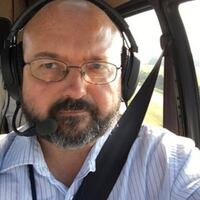Purcell leads Caterpillar’s Clayton Logistics Center, which has quietly operated since it opened in April 2011. And as big as the facility is, it has gotten even bigger since, with a new training center and additional parking spaces for employees.
The company has also invested in robotic cells — robots that build boxes — and plans to invest in a self-guided vehicle system for routine distribution of parts.
Employing about 725 workers — 600 full-time workers and 125 contractors — the center takes in Caterpillar parts and sends them out to distributors and customers. The center packages some 27.3 million pieces of equipment annually, a little over 2.2 million units each month, everything from O-rings to fully assembled engines.
Many residents remember how big a deal the Clayton center was and is. Its construction helped cement the Dayton area’s growing reputation as a viable distribution hub. The project also came in the midst of the Great Recession and was a much-needed economic shot in the arm.
Purcell has worked with Caterpillar for three decades, coming most recently from a Denver distribution center that is about half the size of the Clayton site.
We recently sat down with him to talk logistics, distribution and yes, boxes. What follows is an edited, condensed transcript.
Q: Tell me a bit about yourself.
Purcell: "I've been in Clayton a little bit over a year now, and I'm enjoying it a lot. I've been with CAT for 32 years. I started out as a transfer line machinist making diesel cylinder heads in 1983 with CAT in Lafayette, Ind. I progressed through my career there for almost 20 years …
“I came to CAT with a high school diploma. I got my associate’s degree, my bachelor’s degree and my master’s degree from Purdue. All thanks to Caterpillar. So that was a fantastic benefit for me. I have always been the kind of person who decides to grow where I’m planted.”
Q: Can you put in perspective just how big this building is?
Purcell: "We have a very basic footpath that takes us around the facility. I've been told — I haven't stepped off it myself — but it's about a mile and a quarter. A little over a mile. It's a long walk. I've walked it lots of times.
“The facility in Denver was 57 years old. I walked into this facility, and it was two years old. It’s very impressive from a cleanliness standpoint. … Ultra-modern, a lot of new things.
“One of the things I wasn’t as experienced with was the (center’s) Inbound Processing Center, which is a huge part of what we do here. … We handle yellow iron all day long. We still don’t handle (completely assembled) pieces of equipment like a ‘dozer or an excavator or an off-highway truck. … What we do every day impacts the customer.”
Q: So tell me about the automated guided vehicle system you’re planning. It will carry parts around the building?
Purcell: "The AGV (Automated Guided Vehicle) will do some of the redundant tasks, the material that's slated to go to the outbound docks. It would take it from the IPC (Inbound Processing Center) to the outbound dock, drop it off on a conveyor there, swing around and since it's got to make a trip back anyway, pick up empty 63s (triwall corrugated containers attached to pallets,) and distribute them back into various locations in the facility.
“It’s just going to be set up on a circular path through the facility. It will be bringing material to outbound and picking up empties and delivering them. That’s just a pilot (project). And the thinking is, if that works out well, we can utilize them to a much greater degree.
“They have come a long way in technology. They’ve been around for years, but they’ve come a long way. The pilot isn’t terribly expensive. As a matter of fact, we’re getting some corporate funding. It’s not something we’re paying for directly here.”
Know someone who can handle Three Questions? We're looking for behind-the-scenes-but-still fascinating Miami Valley residents with something to say. Send your suggestions to tom.gnau@coxinc.com.
About the Author
